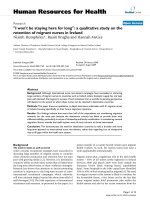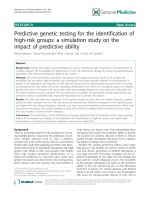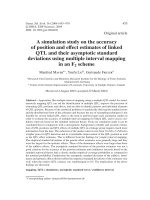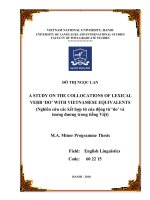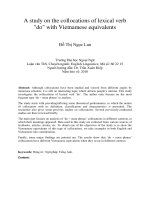A numerical study on the deformation of liquid filled capsules with elastic membranes in simple shear flow
Bạn đang xem bản rút gọn của tài liệu. Xem và tải ngay bản đầy đủ của tài liệu tại đây (15.68 MB, 215 trang )
A NUMERICAL STUDY ON THE DEFORMATION
OF LIQUID-FILLED CAPSULES WITH ELASTIC
MEMBRANES IN SIMPLE SHEAR FLOW
SUI YI
(B. Sci., University of Science and Technology of China)
A THESIS SUBMITTED
FOR THE DEGREE OF DOCTOR OF PHILOSOPHY
DEPARTMENT OF MECHANICAL ENGINEERING
NATIONAL UNIVERSITY OF SINGAPORE
2008
I
ACKNOWLEDGEMENTS
I would like to express my sincere gratitude to my Supervisors, Associate
Professor H. T. Low, Professor Y. T. Chew and Assistant Professor P. Roy, for their
invaluable guidance, encouragement and support on my research and thesis work.
Moreover, I would like to give my thanks to Professor C. S. Peskin (NYU, USA),
Professor Z. L. Li (NCSU, USA) and Professor Z. G. Feng (XU, USA) for their
helpful suggestions and discussions on my research. I also want to thank Dr. H. B.
Huang, Dr. N. S. Liu, Dr. X. Shi and other colleagues in the Fluid Mechanics group
who helped me a lot during the period of my research.
Many people have stood behind me throughout this work. I am deeply grateful to
my wife, Chaibo, my parents and my sister, for their love and their confidence in me.
Finally, I am grateful to the National University of Singapore for granting me the
Research Scholarship and the precious opportunity to pursue a Doctor of Philosophy
degree.
II
Table of Contents
SUMMARY V
NOMENCLATURE VII
LIST OF FIGURES XI
LIST OF TABLES XVII
Chapter 1 Introduction 1
1.1 General background 1
1.2 Motion of a capsule in shear flow 1
1.2.1 Different motion modes 1
1.2.2 Effect of viscosity ratio 3
1.2.3 Effect of membrane viscosity 4
1.2.4 Effect of membrane bending stiffness 5
1.2.5 Effect of shear rate 6
1.3 Numerical methods 8
1.3.1 Arbitrary Lagrangian Eulerian method 8
1.3.2 Advected-field method 9
1.3.3 Boundary element method 9
1.3.4 Immersed boundary method 10
1.3.5 Lattice Boltzmann method 11
1.4 Objectives and scopes 13
1.5 Outline of the thesis 15
Chapter 2 A Two-dimensional Hybrid Immersed Boundary and Multi-block
Lattice Boltzmann Method 17
2.1 Numerical method 18
2.1.1 The lattice Boltzmann method 18
2.1.2 The Multi-block strategy 20
2.1.3 The immersed boundary method 23
2.1.4 The hybrid immersed boundary and multi-block lattice Boltzmann method
25
2.2 Validation of the numerical method 26
III
2.2.1 Flow passing a circular cylinder 26
2.2.2 Two circular cylinders moving with respect to each other 29
2.2.3 Flow around a hovering wing 31
2.2.4 Deformation of a circular capsule in simple shear flow 32
2.3 Concluding remarks 35
Chapter 3 Effect of Membrane Bending Stiffness on the Deformation of Two-
dimensional Capsules in Shear Flow 52
3.1 Numerical model 53
3.1.1. Membrane mechanics 53
3.1.2. Numerical method 56
3.2 Results and discussion 56
3.2.1 Initially circular capsules 56
3.2.2 Initially elliptical capsules 58
3.2.3 Initially biconcave capsules 63
3.3 Concluding remarks 66
Chapter 4 Inertia Effect on the Deformation of Two-dimensional Capsules in
Simple Shear Flow 81
4.1 Numerical model 82
4.2 Results and discussion 83
4.2.1 Numerical performance 84
4.2.2 The capsule deformation 86
4.2.3 Flow structure and vorticity field 89
4.3 Concluding remarks 90
Chapter 5 A Hybrid Method to Study Flow-induced Deformation of Three-
Dimensional Capsules 106
5.1. Membrane model 107
5.1.1 Membrane constitutive laws 107
5.1.2 Membrane disretization 109
5.1.3 Finite element membrane model 109
5.2 Numerical Method 111
5.2.1 The immersed boundary method 111
IV
5.2.2 The multi-block lattice Boltzmann method 113
5.2.3 The hybrid method 115
5.3. Results and Discussion 116
5.3.1 Spherical capsules 117
5.3.2 Oblate spheroidal capsules 123
5.3.3 Biconcave discoid capsules 125
5.4 Concluding remarks 126
Chapter 6 A Shear Rate Induced Swinging-to- Tumbling Transition of Three-
dimensional Elastic Capsules in Shear Flow 149
6.1. Initially spherical capsules 151
6.2. Initially oblate spheroidal capsules 153
6.2.1. Swinging motion 154
6.2.2. Swinging-to-tumbling transition 155
6.3. Initially biconcave discoid capsules 157
6.3.1. Swinging motion 158
6.3.2. Swinging-to-tumbling transition 160
6.4. Discussion 160
6.5. Concluding remarks 164
Chapter 7 Conclusions and Recommendations 181
7.1 Conclusions 181
7.2 Recommendations 184
Reference 186
V
SUMMARY
In this thesis, a hybrid numerical method was developed to study the flow-induced
deformation of capsules. Based on the numerical model proposed, the transient
deformation of capsules, which consist of Newtonian liquid drops enclosed by elastic
membranes, in simple shear flow was studied. Effects of membrane bending stiffness,
inertia and shear rate on the capsule deformation were investigated.
In the hybrid method, the immersed boundary concept was developed in the
framework of the lattice Boltzmann method, and the multi-block strategy was
employed to improve the accuracy and efficiency of the simulation. The present
method was validated by comparison with several benchmark computations. The
results showed that the present method is accurate and efficient in simulating two-
dimensional solid and elastic boundaries interacting with fluids.
Based on the hybrid method, the transient deformation of two-dimensional liquid
capsules, enclosed by elastic membranes with bending rigidity, in shear flow was
studied. The results showed that for capsules with minimum bending-energy
configurations having uniform curvature, the membrane carries out tank-treading
motion. For elliptical and biconcave capsules with resting shapes as minimum
bending-energy configurations, it was quite interesting to find that with the bending
stiffness increasing or the shear rate decreasing, the capsules’ motion changes from
tank-treading mode to tumbling mode, and resembles Jeffery’s tumbling mode at
large bending stiffness.
Inertia effect on the transient deformation of two-dimensional liquid-filled capsule
with elastic membrane in simple shear flow was studied. The simulation results
VI
showed that the inertia effect gives rise to a transient process, in which the capsule
elongation and inclination overshoot and then show dampened oscillations towards
the steady states. Inertia effect also promotes the steady deformation, and decreases
the tank treading frequency of the capsule. Furthermore, inertia strongly affects the
flow structure and vorticity field around and inside the capsule.
The hybrid method was extended to three-dimensional, and a finite element model
was incorporated to obtain the forces acting on the membrane nodes of the three-
dimensional capsule which was discretized into flat triangular elements. The present
method was validated by studying the transient deformation of initially spherical and
oblate spheroidal capsules with various membrane laws under shear flow. The
transient deformation of capsules with initially biconcave disk shape was also
simulated. The unsteady tank treading motion was followed for a whole period in the
present work.
The dynamic motion of three-dimensional capsules in shear flow was investigated.
The results showed that spherical capsules deform to stationary configurations and
then the membranes rotate around the liquid inside (steady tank-treading motion).
Such a steady mode was not observed for non-spherical capsules. It was shown that
with the shear rate decreasing, the motion of non-spherical capsules changes from the
swinging mode (the capsule undergoes periodic shape deformation and inclination
oscillation while its membrane is rotating around the liquid inside) to tumbling mode.
VII
NOMENCLATURE
Roman Letters
a
a
i
b
i
B
c
c
i
c
s
C
C
d
C
l
d
i
D
xy
, D
xz
e
i
E
E
B
E
b
f
f
f
i
f
i
eq
F
F
d
F
l
I
1
, I
2
equivalent radius
shape parameter
shape parameter
width of a capsule
velocity Δx/Δt
shape parameter
speed of sound
ratio of membrane shear elasticity modulus and membrane
dilation modulus
drag coefficient
lift coefficient
shape parameter
Taylor shape parameter
particle velocity vector along direction i
shear elasticity modulus
bending modulus
reduced bending modulus
Eulerian fluid force density
tank-treading frequency
particle distribution function
equilibrium particle distribution function
Lagrangian boundary force
drag force
lift force
strain invariants
VIII
G
k
l(t)
L
m
n
p
q
r
R
Re
s
St
Δt
t
t
T
u
U
U
t
U
∞
V
e
W
x
Δx
dimensionless shear rate
shear rate
instantaneous arc distance along the membrane
length of a capsule
bending moment
normal direction
pressure
transverse shear tension
distance between the Lagrange and Eulerian nodes divided by
the Eulerian grid space
volume adjusting factor
Reynolds number
spatial position vector in Lagrangian frame
Strouhal number
time step
tangential direction
time
membrane tension
fluid velocity vector
characteristic velocity
average tank-treading velocity
incoming fluid velocity
area of the element
strain energy density
spatial position vector in Eulerian frame
lattice space
IX
Greek Letters
α
θ
λ
μ
ν
δ
ρ
ε
ω
ω
i
Ω
Γ
angle of attack
inclination angle of a capsule
principle strain
fluid viscosity
kinetic fluid viscosity
Dirac delta function
fluid density
capillary number
normalized vorticity magnitude
weight coefficients for the equilibrium distribution function
fluid domain
Lagrangian boundary
Superscriprs
eq
n
f
c
t
local equilibrium
normal part
fine grid
coarse grid
tangential part
Subscriprs
i
xy
xz
0
the component in direction e
i
x-y plane
x-z pane
initial state
X
Abbreviations
2D
3D
ALE
BEM
IBM
LBE
LBM
NH
SK
ZT
RBC
two-dimensional
three-dimensional
arbitrary Lagrangian Eulerian
boundary element method
immersed boundary method
lattice Boltzmann equation
lattice Boltzmann method
Neo-hookean
Skalak
Zero-thickness
Red blood cell
XI
LIST OF FIGURES
Figure 2.1 D2Q9 lattice model 38
Figure 2.2 Interface structures between two blocks 38
Figure 2.3 An elastic boundary immersed in a fluid 39
Figure 2.4 General computational procedure 40
Figure 2.5 Illustration of mesh and block system on the computational domain of flow
past a circular cylinder. The block area is adjusted and the mesh density is reduced by
a factor of 25 for clarity 41
Figure 2.6 Evolution of force coefficients for flow past a circular cylinder at Re = 100
and 200: (a) drag, (b) lift 42
Figure 2.7 Stream function contour for flow past a circular cylinder at: (a) Re = 100,
(b) Re = 200 43
Figure 2.8 Pressure contours for flow past a circular cylinder at: (a) Re = 100, (b) Re
= 200 44
Figure 2.9 Vorticity contours for flow past a circular cylinder at: (a) Re = 100, (b) Re
= 200 45
Figure 2.10 Computational geometry for two cylinders moving respect to each other
45
Figure 2.11 Vorticity fields around two cylinder moving with respect to each other; (a)
cylinders are closest to each other; (b) cylinders are separated by a distance of 16 46
Figure 2.12 Temporal evolution of (a) Lift and (b) Drag coefficients for the upper
cylinder in flow around two cylinder moving respect to each other 47
Figure 2.13 Positions of a hovering wing in one period. The solid ellipses represent
the downstroke phase and the dotted ellipses represent the upstroke phase 47
Figure 2.14 Vorticity fields around a hovering wing at four different instants in a
period 48
Figure 2.15 Temporal evolution of (a) Drag and (b) Lift coefficients for flow around a
hovering wing at Re = 157 49
Figure 2.16 The streamline pattern inside and outside the capsule at steady state 50
XII
Figure 2.17 Temporal evolution of : (a) Taylor deformation parameter; (b) orientation
angle. _______, present method;
●, boundary element method (Breyiannis and
Pozrikidis, 2000) 50
Figure 2.18 Temporal evolution of Taylor deformation parameter for different grid
resolutions 51
Figure 2.19 Temporal evolution of Taylor deformation parameter for different size of
computational domains 51
Figure 3.1 Schematic illustration of a two-dimensional capsule in simple shear flow68
Figure 3.2 Contours of steady deformed capsules with circular initial shape for
various bending modulus at dimensionless shear rate: (a)
0.04G
=
; (b)
0.125G =
68
Figure 3.3 Temporal evolution of Taylor deformation parameter for: (a)
0.04G =
;
(b)
0.125G =
; and inclination angle for: (c)
0.04G
=
; (d)
0.125G
=
69
Figure 3.4 The normalized tank treading frequency for various reduced bending
modulus at
0.04G =
and 0.125 70
Figure 3.5 Configurations of steady deformed capsules with elliptical initial shape
and circular minimum bending-energy configuration under various bending modulus
at dimensionless shear rate: (a)
0.04G
=
; (b)
0.125G
=
70
Figure 3.6 Steady (a) Taylor deformation parameters; (b) inclination angles of
capsules with different reduced bending modulus at
0.04G
=
and 0.125 71
Figure 3.7 Tank treading motion of capsules with the elliptical initial shape as the
minimum bending-energy configuration at different bending modulus at
0.04G =
71
Figure 3.8 Rotating and deforming of a capsule with the elliptical initial shape as the
minimum bending-energy configuration at
0.06
b
E
=
and 0.04G
=
. Corresponding
dimensionless time are
kt =
(a) 0, (b) 1.6, (c) 6.4, (d) 8 72
Figure 3.9 Rotating and deforming of a capsule with the elliptical initial shape as the
minimum bending-energy configuration at
0.4
b
E
=
and 0.04G
=
72
Figure 3.10 Evolution of inclination angle of capsules with the elliptical initial shape
as the minimum bending-energy configuration at
0.04G
=
73
Figure 3.11 Instantaneous snapshots of elliptical capsules’ profiles during
deformation at
0.01
b
E =
, (a)
0.04G
=
; (b)
0.0125G
=
; (a)
0.00625G
=
; (d)
0.001G =
74
Figure 3.12 Evolution of inclination angle of capsules with the elliptical initial shape
as the minimum bending-energy configuration at
0.01
b
E
=
75
XIII
Figure 3.13 Equilibrium shapes of initially biconcave capsules with circular minimum
bending-energy configuration at reduced bending modulus
b
E
=
(a) 0, (b) 0.005, (c)
0.02, (d) 0.1 at
0.025G =
75
Figure 3.14 Tank treading and deforming of a capsule with the elliptical biconcave
shape as the minimum bending-energy configuration at
0.015
b
E
=
and 0.025G = 76
Figure 3.15 Rotating and deforming of a capsule with the elliptical biconcave shape
as the minimum bending-energy configuration at 0.02
b
E
=
and 0.025G
=
.
Corresponding dimensionless times are kt
=
(a) 0, (b) 1.26, (c) 7.38, (d) 14.22,
(e)15.66 76
Figure 3.16 Rotating and deforming of a capsule with the elliptical biconcave shape
as the minimum bending-energy configuration at 0.2
b
E
=
and 0.025G
=
77
Figure 3.17 Evolution of inclination angle of capsules with the biconcave initial shape
as the minimum bending-energy configuration at: (a)
0.025G
=
; (b)
0.0025G =
78
Figure 3.18 Instantaneous snapshots of biconcave capsules’ profiles during
deformation at
0.01
b
E =
, (a)
0.04G
=
; (b)
0.02G
=
; (a)
0.01G
=
; (d)
0.001G =
79
Figure 3.19 Evolution of inclination angle of capsules with the biconcave initial shape
as the minimum bending-energy configuration at
0.01
b
E
=
80
Figure 4.1 Schematic illustration of a two-dimensional circular capsule in simple
shear flow 92
Figure 4.2 Temporal evolution of the capsule’s (a) Taylor shape parameter; (b)
inclination angle under various domain sizes at Re = 100 93
Figure 4.3 Temporal evolution of the capsule’s (a) Taylor shape parameter; (b)
inclination angle under various grid resolutions at Re = 100 94
Figure 4.4 Effect of Reynolds number on the evolution of Taylor shape parameter of
the capsule under various simensionless shear rates. (a) Re = 1 (
● is the result of
Breyiannis and Pozrikids (2000) for Re = 0); (b) Re = 10; (c) Re = 50; (d) Re = 10095
Figure 4.5 Effect of Reynolds number on the evolution of inclination angle of the
capsule under various simensionless shear rates. (a) Re = 1(
● is the result of
Breyiannis and Pozrikids (2000) for Re = 0); (b) Re = 10; (c) Re = 50; (d) Re = 10096
Figure 4.6 Steady configurations of capsules at various Reynolds numbers.(a) G =
0.003125; (b) G = 0.04 97
Figure 4.7 (a) Averge tank treading velocity; (b) tank treading frequency of capsules
at various dimensionless shear rates and Reynolds numbers 97
XIV
Figure 4.8 Stream patterns and velocity vectors around the capsule for G = 0.003125.
(a) Re = 1; (b) Re = 10; (c) Re = 50; (d) Re = 100 99
Figure 4.9 Stream patterns and velocity vectors around the capsule for G = 0.04. (a)
Re = 1; (b) Re = 10; (c) Re = 50; (d) Re = 100 101
Figure 4.10 Three-dimensional and contour plots of vorticity for G = 0.003125 at (a)
Re = 1; (b) Re = 10; (c) Re = 50; (d) Re = 100 103
Figure 4.11 Three-dimensional and contour plots of vorticity for G = 0.04 at (a) Re =
1; (b) Re = 10; (c) Re = 50; (d) Re = 100 105
Figure 5.1 Discretization of (a) a sphere; (b) a biconcave disk shape 128
Figure 5.2 D3Q19 model 128
Figure 5.3 Interface structures between two blocks 129
Figure 5.4 Illustration of a capsule in simple shear flow 129
Figure 5.5 Temporal evolution of the capsule’s Taylor shape parameter at G = 0.2
under various (a) computational domain sizes; (b) grid resolutions 130
Figure 5.6 Steady deformed capsule and the flow field around the cross section of the
capsule in the plane of shear (x-z plane) 131
Figure 5.7 Temporal evolution of (a) Taylor shape parameter; (b) inclination angle of
the initially spherical capsules with NH membranes. The symbols ♦ represent the
results of Lac et al. (2004) with the boundary element method. The straight horizontal
bold line represents the predictions of the second order small-deformation theory of
Barthès-Biesel (1980) for G = 0.0125, 0.025, 0.05 132
Figure 5.8 Cross sections of the steady formed capsules in the plane of shear 133
Figure 5.9 Temporal evolution of (a) Taylor shape parameter; (b) inclination angle of
the initially spherical capsules with SK membranes. The straight horizontal bold line
represents results of Lac et al. (2004) 134
Figure 5.10 Temporal evolution of (a) Taylor shape parameter; (b) inclination angle
of spherical capsules with NH membrane at G = 0.05 under various Reynolds
numbers 135
Figure 5.11 Temporal evolution of (a) Taylor shape parameter; (b) inclination angle
of spherical capsules with NH membrane at G = 0.1 under various Reynolds numbers
136
Figure 5.12 Flow fields in the plane of shear (x-z plane) around the cross sections of
the capsules for G = 0.1 at Re = (a) 0.25; (b) 2.5; (c) 10 and (d) 25 138
XV
Figure 5.13 Three-dimensional steady profiles of the capsules at Re = (a) 0.25; (b) 2.5;
(c) 10; (d) 25 140
Figure 5.14 Snapshots of an initially oblate spheroidal capsule’s cross section in the
plane of shear during the tank treading motion. The symbol
● represents the same
membrane node which is moving 141
Figure 5.15 Temporal evolution of (a) Taylor shape parameter; (b) inclination angle
of oblate spheroidal capsules with semimajor to semiminor axes ratio of 10:9 142
Figure 5.16 Temporal evolution of (a) Taylor shape parameter; (b) inclination angle
of oblate spheroidal capsules with semimajor to semiminor axes ratio of 2:1 143
Figure 5.17 Temporal evolution of the inclination angle of the initially biconcave
capsule 144
Figure 5.18 Snapshots of the capsule during the tank-treading motion. The diamond
symbol represents the same membrane node on the capsule’s cross section in the
plane of shear 147
Figure 5.19 Temporal evolution of the capsule’s length and width 148
Figure 6.1 Steady deformed capsule and the flow field around the cross section of the
capsule in the plane of shear at G = 0.05 165
Figure 6.2 Temporal evolutions of the (a) Taylor shape parameter, (b) inclination
angle of the initially spherical capsules with ZT membrane 166
Figure 6.3 Temporal evolutions of the (a) Taylor shape parameter, (b) inclination
angle of the initially spherical capsules with SK membrane at C = 100 167
Figure 6.4 Membrane profiles in the plane of shear for initially oblate spheroidal
capsules with aspect ratio of 3:2. (a)
0.2G
=
; (b)
0.05G
=
; (c)
0.0125G
=
168
Figure 6.5 3D profiles of the capsule (in Fig. 6(a)) during the swinging motion. The
dimensionless time kt = (a) 3; (b) 5; (c) 7; (d) 9; (e) 11; (f) 13 170
Figure 6.6 Temporal evolutions of the (a) Taylor shape parameter, (b) inclination
angle of the initially oblate spheroidal capsules (aspect ratio 3:2) with ZT membrane
171
Figure 6.7 Oscillation amplitudes of the (a) Taylor shape parameter, (b) inclination
angle of the initially oblate spheroidal capsules (aspect ratio 3:2) with ZT membrane
172
Figure 6.8 Temporal evolutions of the inclination angle of the initially oblate
spheroidal capsules with ZT membrane, the aspect ratios are (a) 10:9; (b) 2:1 173
XVI
Figure 6.9 Temporal evolutions of the inclination angle of the initially oblate
spheroidal capsules (aspect ratio 3:2) with SK membrane at C = 100 174
Figure 6.10 Temporal evolutions of the inclination angle of the initially oblate
spheroidal capsules (aspect ratio 3:2) with ZT membrane at G = (a) 0.0221; (b)
0.0225 175
Figure 6.11 A periodic suspension of initially biconcave-discoid cells in shear flow
176
Figure 6.12 Profiles of the ghost cell in the swinging motion at G = 1.87 and kt = (a)
5; (b) 9; (c) 13; (d) 17 177
Figure 6.13 Temporal evolution of the ghost cell’s length (L
1
), width (L
2
) and
thickness (L
3
) under various dimensionless shear rates 178
Figure 6.14 Temporal evolution of the inclination angle of the ghost cell’s middle
cross section (in the plane of shear) under various dimensionless shear rates 178
Figure 6.15 Tank-treading frequency of the ghost cell membrane under various
dimensionless shear rates 179
Figure 6.16 Temporal evolution of the inclination angle of the ghost cell’s middle
cross section (in the plane of shear) under various dimensionless shear rates 179
Figure 6.17 3D profiles of the ghost cell during the tumbling motion. The
dimensionless time kt = (a) 2; (b) 6; (c) 9; (d) 11; (e) 13 and G = 0.0005 180
XVII
LIST OF TABLES
Table 2.1 Comparison with previous studies on flow past a circular cylinder 377
Table 2.2 Drag coefficients for different grid size 377
Table 2.3 Comparison of flow characteristics for flow past a circular cylinder 377
Chapter 1 Introduction
1
Chapter 1 Introduction
1.1 General background
Capsules consisting of thin elastic or incompressible membranes enclosing viscous
Newtonian liquid are often employed as models for many kinds of particles, including
biological cells, eggs, lipid vesicles, etc. The flow-induced deformation of such a
capsule has attracted much attention in the past few decades. The physics involved is
important not only in fundamental research, but also in medical and industrial
applications. For example, in blood diseases like cerebral malaria and sickle cell
anemia, red blood cells lose their ability to deform and often block the capillaries due
to the membranes becoming stiffer. To design clinical therapies for such blood
diseases, it is necessary to understand how the interfacial mechanical properties affect
the deformation of cells under flow. The knowledge is also important in other areas
like microencapsulation to design capsules with desired properties. Furthermore, it is
the first step to model more complex flow situations which involve capsule
suspensions, such as human microcirculation, cell filtration and drug delivery.
1.2 Motion of a capsule in shear flow
1.2.1 Different motion modes
The dynamic motion of a capsule under shear flow has been studied experimentally,
theoretically and numerically. Two types of motion are well-known: the tank-treading
mode and the tumbling mode.
Chapter 1 Introduction
2
In the tank-treading mode, the capsule deforms to a steady configuration then the
membrane rotates around the liquid inside. Schmid-Schönbein and Wells (1969), as
well as Goldsmith (1971) were the first to experimentally demonstrate that red blood
cells carry out tank-treading motion in shear flow, when the matrix fluid is much
more viscous than the internal liquid of the cell and the shear rate is high. The tank-
treading motion has also been observed in subsequent experiments of red blood cells
(Fischer et al. 1978; Tran-Song-Tay et al.1984) or vesicles (de Hass et al. 1997) in
shear flow. Vesicles are liquid-filled capsules with incompressible membrane, which
has no shear elasticity. With small deformation theory, Barthès-Biesel (1980) as well
as Barthès-Biesel and Rallison (1981) first predicted the tank-treading motion of
spherical liquid-filled capsules with elastic or incompressible membranes in shear
flow. The tank-treading motion has also been observed in studies by numerical
simulation (Pozrikis 1995; Kraus et al. 1996; Eggleton and Popel 1998; Lac et al.
2004). The numerical simulations were not limited to small deformation.
In the tumbling mode, a capsule flips continuously. The tumbling motion of red
blood cells in shear flow has been observed in experiments when the viscosity ratio of
the internal liquid to the external liquid is high (Pfafferott et al. 1985) or the shear rate
is low (Abkarian et al. 2007). The tumbling motion has also been observed, on non-
spherical capsules, in studies by theoretical analysis (Keller and Skalak 1982; Misbah
2006; Skotheim and Secomb, 2007) as well as by numerical simulation (Ramanujan
and Pozrikis 1998; Biben and Misbah 2003; Beaucourt et al. 2004).
Besides these two modes, a new “swinging” mode has been observed in recent
experiments for non-spherical capsules (Walter 2001; Abkarian et al. 2007). The
Chapter 1 Introduction
3
swinging mode is similar to the tank-treading mode, because the capsule’s membrane
also rotates around the liquid inside. The difference from the tank-treading mode is
that when the membrane is rotating, the capsule undergoes periodic shape
deformation and inclination oscillation. The swinging mode has also been predicted
theoretically (Misbah, 2006; Abkarian et al. 2007; Skotheim and Secomb, 2007;
Noguchi and Gompper 2007) and numerically (Ramanujan and Pozrikis 1998;
Noguchi and Gompper 2007).
The dynamic motion of a capsule under shear flow has been studied extensively.
Several factors have been identified important in determining a capsule’s motion
mode, including the viscosity ratio of the internal fluid and the external fluid, the
membrane viscosity, the membrane bending stiffness and the shear rate.
1.2.2 Effect of viscosity ratio
In shear flow, it has been found that capsules immersed in a low viscosity fluid
tumble continuously, and capsules immersed in a fluid with sufficiently high viscosity
carry out tank-treading motion. Goldsmith and Marlow (1972) were the first to
experimentally observe this phenomenon on red blood cells. Later on, Pfafferott et al.
(1985) found in experiments that when a red cell was subjected to shear flow, it
underwent tank-treading motion approximately when the viscosity ratio (defined as
the ratio of the internal fluid viscosity to the external fluid viscosity in this thesis) was
less than two, and tumbling motion for higher viscosity ratios.
Keller and Skalak
(1982) theoretically analyzed the dynamic motion of an
ellipsoidal capsule in simple shear flow. It was found that for a capsule with a given
Chapter 1 Introduction
4
geometry, the transition from tank-treading mode to tumbling mode depends on the
viscosity ratio between internal fluid and external fluid, and it is independent of shear
rate. In Keller and Skalak’s theory, the capsule was assumed to have a fixed shape.
Rioual et al. (2004) also predicted this viscosity ratio induced transition with another
analytical model, which was based on general considerations and does not resort to
the explicit computation of the full hydrodynamic field inside and outside the vesicle.
This viscosity ratio dependent transition has also been recovered in numerical
studies by Pozrikidis and co-workers (Ramanujan and Pozrikids, 1998; Pozrikidis,
2003) with boundary element method, as well as by Misbah and co-workers (Biben
and Misbah, 2003; Beaucourt et al. 2004) with advected-field approach.
1.2.3 Effect of membrane viscosity
Barthès-Biesel and Sgaier (1985) theoretically studied liquid-filled capsules with
viscoelastic membranes in shear flow. A regular perturbation solution of initially
spherical capsules undergoing small deformation was obtained. It was found that with
a purely viscous membrane (infinite relaxation time) the capsule deforms into an
ellipsoid with a continuous tumbling motion; when the membrane relaxation time was
of the same order as the shear time, the particle reaches a steady ellipsoidal shape
with an inclination angle between 0° and 45°.
Noguchi and Gompper (2004, 2005, 2007) numerically studied vesicles with
viscous membranes in simple shear flow. It was found that increasing the viscosity of
Chapter 1 Introduction
5
membrane will cause the capsule’s motion change from tank-treading mode to
tumbling mode.
In fact, the tank-treading to tumbling transition may be induced by either
increasing the viscosity ratio or increasing the membrane viscosity. In both cases due
to the fact that the viscosity increases, the transfer of shear torque to the membrane
(or its underlying bulk) becomes more and more difficult (because of increasing
dissipation), and then the capsule would behave like a solid body which then
undergoes tumbling.
1.2.4 Effect of membrane bending stiffness
For liquid filled capsules enclosed by elastic membrane, flow induced deformation
causes the development of not only in-plane elastic tensions, but also bending
moments accompanied by transverse shear tensions. The interfacial bending moments
develop physically due to the non-zero membrane thickness; the bending moments
may also be generated because the membrane has a preferred configuration due to its
certain structure. The bending moments is expressed by a constitutive law which
involves the instantaneous Cartesian curvature tensor, curvature of the minimum
bending-energy configuration, and the bending modulus. The bending modulus is
generally independent of the in-plane elasticity modulus, and describes the flexural
stiffness of the membrane.
For fluid capsules enclosed by lipid-bilayer membrane, such as red blood cells, the
bending stiffness has been found to be quite important in determining the equilibrium
configuration and shape oscillations (Fung, 1965; Lipowsky, 1991). For non-
Chapter 1 Introduction
6
equilibrium conditions such as capsules under flow, membrane bending rigidity also
plays a significant role in avoiding the development of wrinkling and folding. For
capsules whose membrane has a preferred configuration, it can be expected that
bending stiffness will ensure that the capsule shape should not deviate greatly from its
preferred profile. It is thus meaningful to investigate the effect of bending stiffness on
the flow-induced deformation of liquid filled capsules enclosed by elastic membrane.
However, the bending effect has not been explored much and most previous studies
neglected bending resistance. The numerical study of Pozrikidis (2001) of liquid-
filled elastic capsules in simple shear flow, as well as Kwak and Pozrikids (2001) of
axisymmtric capsules in uniaxial extensional flow showed that bending stiffness has
significant rounding effect on the steady configuration of capsules. However, an
important restriction in their studies was the requirement that the minimum bending-
energy shape has uniform curvature. So far, there is no study on the transient
deformation of elastic capsules whose minimum bending-energy configuration has
non-uniform curvature.
1.2.5 Effect of shear rate
For a capsule in shear flow, it has been long recognized that the deformation of the
capsule will be larger at higher shear rate. In the well know theory of Keller and
Skalak
(1982), it was found that for a capsule with a given geometry, the transition
from tank-treading mode to tumbling mode depends on the viscosity ratio and it was
independent of shear rate.
Chapter 1 Introduction
7
Recently, Walter et al. (2001)
studied synthetic microcapsules, which were not
perfectly spherical, in shear flow by experiment. It was found that during the tank-
treading motion of the membrane, the capsule undergoes periodic shape deformation
and inclination oscillation; the inclination oscillation amplitude increases as the shear
rate decreases. Similar motion has also been found on red blood cells in shear flow by
Abkarian et al. (2007): the cells present an oscillation of their inclination
superimposed to the tank-treading motion, and the tank-treading-to-tumbling
transition can be triggered by decreasing the shear rate. These novel experimental
findings show that in shear flow, the dynamics of these capsules depends not only on
viscosity ratio, but also on shear rate. Obviously, these findings cannot be recovered
by the theory of Keller and Skakak (1982), which assumed a fixed configuration of
the capsule.
Only recently, there are some pioneering analyses on these phenomena. Based on
Keller and Skalak’s theory, and further assuming that the membrane elastic energy
undergoes a periodic variation during the tank-treading motion, the above
experimental findings can be successfully predicted by the theoretical model of
Skotheim and Secomb (2007) and Abkarian et al. (2007). Noguchi and Gompper
(2007) numerically studied the three-dimensional vesicles with viscous membranes. It
was also found that there is a shear-rate induced transition of vesicles’ motion from
swinging mode to tumbling mode. For liquid-filled capsules with elastic membrane,
the shear-rate induced transition of capsules’ motion has not been reported in studies
with which take the capsule deformation into account.



